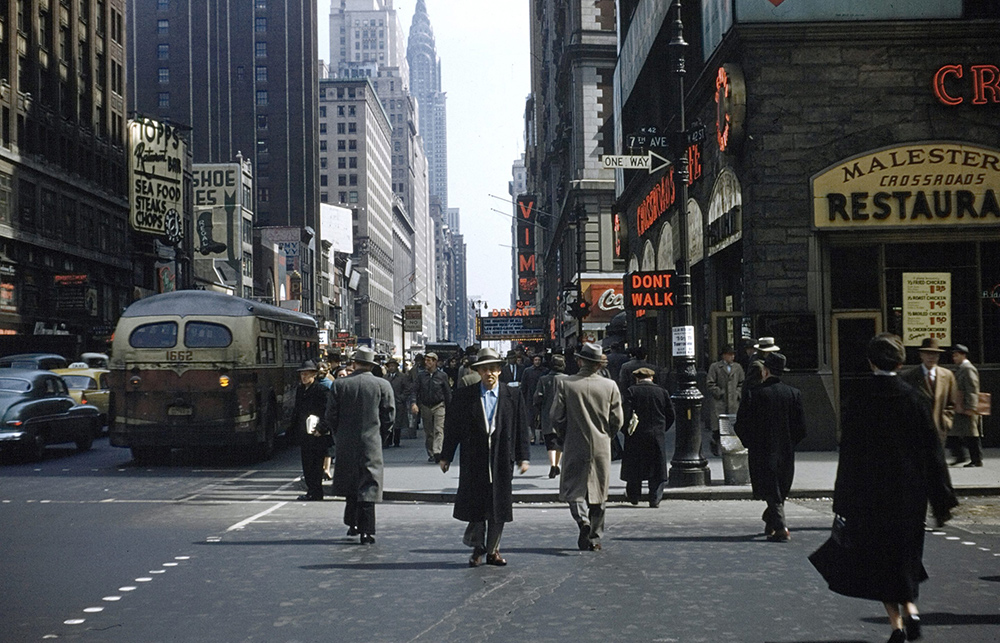
美國即將迎來第四次城市技術(shù)革命。鐵路、電網(wǎng)和汽車定義了以前的時(shí)代,而如今在城市中整合新技術(shù)的發(fā)展策略將發(fā)揮驚人的潛力。
首先,美國的城市建筑可以顯著地提高可持續(xù)性、適應(yīng)性和經(jīng)濟(jì)性。其次,能源系統(tǒng)和基礎(chǔ)設(shè)施可以實(shí)現(xiàn)“氣候正效益”發(fā)展的承諾。此外,數(shù)字基礎(chǔ)設(shè)施可以在安全保密的前提下促進(jìn)人際交往和改善服務(wù)。美國還可以部署移動(dòng)出行方案,實(shí)時(shí)調(diào)節(jié)人流和車流,緩解交通并減少碳排放。最后,創(chuàng)新的社會(huì)基礎(chǔ)設(shè)施可以推出嶄新的服務(wù)模式,建立真正包容的社區(qū)。
美國國會(huì)和政府目前正在協(xié)商一項(xiàng)和解方案,旨在使國家走上一條可持續(xù)及公平發(fā)展的道路。然而,這項(xiàng)使命的成功需要建立在深入投資技術(shù)解決方案的基礎(chǔ)上,并承認(rèn)城市和市縣在諸多國家重點(diǎn)項(xiàng)目中的前線角色。
美國城市的建設(shè)、互聯(lián)、供電、供暖和運(yùn)作與過去75年基本相同。城市仍然普遍依賴于“愚蠢落后”的基礎(chǔ)設(shè)施,比如傳統(tǒng)的交通信號燈只能指揮交通,幾乎沒有其他作用。
上世紀(jì)20年代,底特律設(shè)置了第一個(gè)紅黃綠自動(dòng)交通信號燈,它開創(chuàng)了最先進(jìn)的交通管理技術(shù)。很快,美國的每個(gè)主要十字路口都裝上了紅綠燈,它從那時(shí)起就一直是城市技術(shù)的標(biāo)志。對于美國的城市來說,依靠100年前的技術(shù)并不罕見。如果你仔細(xì)觀察該國的任何一座城市,會(huì)發(fā)現(xiàn)這種情況相當(dāng)普遍。雖然國家的政策需求和技術(shù)能力發(fā)生了巨大變化,但美國城市所依賴的體系自二戰(zhàn)以來基本處在停滯狀態(tài)。
美國意識(shí)到必須利用今天的技術(shù),利用人工智能、機(jī)器學(xué)習(xí)、數(shù)據(jù)分析、互聯(lián)基礎(chǔ)設(shè)施、云計(jì)算和自動(dòng)化去運(yùn)作城市。這也是他們?yōu)槭裁磿?huì)協(xié)力形成一個(gè)新倡議——城市創(chuàng)新聯(lián)盟,以重新構(gòu)想未來的城市基礎(chǔ)設(shè)施。該聯(lián)盟由領(lǐng)先的城市思想家、企業(yè)和非營利組織組成,呼吁國會(huì)和政府抓住這一代人的機(jī)會(huì),釋放城市的潛力,以此強(qiáng)力應(yīng)對氣候變化、促進(jìn)包容和解決最棘手的挑戰(zhàn)。
城市渴望創(chuàng)新,但需要聯(lián)邦政府的支持和投資來實(shí)現(xiàn)這一點(diǎn)。2015年,美國交通部發(fā)起了聯(lián)邦智能城市挑戰(zhàn)賽,吸引了78座城市提出資助申請。這些扶助措施包括用智能LED燈取代傳統(tǒng)路燈以減少能源消耗,監(jiān)測空氣質(zhì)量,以及建立通暢的貨運(yùn)優(yōu)先通道和信號,緩解交通并減少排放。
俄亥俄州的哥倫布市最終贏下了這項(xiàng)比賽,他們得以建設(shè)一個(gè)開源的交通數(shù)據(jù)中心,還在一個(gè)居民區(qū)率先推出第一輛自動(dòng)駕駛公共穿梭班車,并試點(diǎn)互聯(lián)車輛技術(shù)以提高安全性。但從那以后,城市的發(fā)展一直缺乏聯(lián)邦領(lǐng)導(dǎo),因此無法系統(tǒng)地進(jìn)行現(xiàn)代化,也面臨資金不足的窘境。
美國國會(huì)目前的基礎(chǔ)設(shè)施提案可圈可點(diǎn),其中包括實(shí)施擁擠收費(fèi)策略。和解法案如果能實(shí)際投入資金幫助城市創(chuàng)新,可能會(huì)產(chǎn)生更大的影響。城市創(chuàng)新聯(lián)盟最近致信國會(huì)領(lǐng)導(dǎo)人,提出了幾項(xiàng)推動(dòng)城市創(chuàng)新的具體策略,他們早該如此。
考慮到75%的排放來自城市,聯(lián)邦政府行動(dòng)若推動(dòng)城市綠色技術(shù)研究,可能會(huì)收到巨大的回報(bào)。聯(lián)邦政府對美國太陽能產(chǎn)業(yè)的推動(dòng)有目共睹,他們也需要在促進(jìn)城市氣候技術(shù)開發(fā)方面發(fā)揮領(lǐng)導(dǎo)作用,從而打造系統(tǒng)去優(yōu)化多式聯(lián)運(yùn)、減少與建筑相關(guān)的排放,并加速向電氣化過渡。這也是為什么聯(lián)盟敦促國會(huì)將“城市創(chuàng)新”作為交通和能源部門高級研究的優(yōu)先事項(xiàng)。
面對一些足以改變世界的想法和方法,城市社區(qū)在孵化、測試、展示和領(lǐng)導(dǎo)等方面的能力與一個(gè)世紀(jì)之前保持一致。美國如果不支持城市創(chuàng)新,將無法實(shí)現(xiàn)其最重要的目標(biāo)。國會(huì)和政府是時(shí)候抓住面前的機(jī)會(huì),投資建設(shè)更強(qiáng)大的城市社區(qū),讓它們比以往任何時(shí)候都更公平和可持續(xù)。(財(cái)富中文網(wǎng))
理查德·佛羅里達(dá)是加拿大多倫多大學(xué)的教授,也是媒體公司 CityLab的聯(lián)合創(chuàng)始人,此外還著有《創(chuàng)意階層的崛起》和新書《新城市危機(jī)》。丹尼爾·L·多克托羅夫是城市創(chuàng)新公司 Sidewalk Labs的首席執(zhí)行官,該公司歸谷歌母公司Alphabet所有。
譯者:秦維奇
美國即將迎來第四次城市技術(shù)革命。鐵路、電網(wǎng)和汽車定義了以前的時(shí)代,而如今在城市中整合新技術(shù)的發(fā)展策略將發(fā)揮驚人的潛力。
首先,美國的城市建筑可以顯著地提高可持續(xù)性、適應(yīng)性和經(jīng)濟(jì)性。其次,能源系統(tǒng)和基礎(chǔ)設(shè)施可以實(shí)現(xiàn)“氣候正效益”發(fā)展的承諾。此外,數(shù)字基礎(chǔ)設(shè)施可以在安全保密的前提下促進(jìn)人際交往和改善服務(wù)。美國還可以部署移動(dòng)出行方案,實(shí)時(shí)調(diào)節(jié)人流和車流,緩解交通并減少碳排放。最后,創(chuàng)新的社會(huì)基礎(chǔ)設(shè)施可以推出嶄新的服務(wù)模式,建立真正包容的社區(qū)。
美國國會(huì)和政府目前正在協(xié)商一項(xiàng)和解方案,旨在使國家走上一條可持續(xù)及公平發(fā)展的道路。然而,這項(xiàng)使命的成功需要建立在深入投資技術(shù)解決方案的基礎(chǔ)上,并承認(rèn)城市和市縣在諸多國家重點(diǎn)項(xiàng)目中的前線角色。
美國城市的建設(shè)、互聯(lián)、供電、供暖和運(yùn)作與過去75年基本相同。城市仍然普遍依賴于“愚蠢落后”的基礎(chǔ)設(shè)施,比如傳統(tǒng)的交通信號燈只能指揮交通,幾乎沒有其他作用。
上世紀(jì)20年代,底特律設(shè)置了第一個(gè)紅黃綠自動(dòng)交通信號燈,它開創(chuàng)了最先進(jìn)的交通管理技術(shù)。很快,美國的每個(gè)主要十字路口都裝上了紅綠燈,它從那時(shí)起就一直是城市技術(shù)的標(biāo)志。對于美國的城市來說,依靠100年前的技術(shù)并不罕見。如果你仔細(xì)觀察該國的任何一座城市,會(huì)發(fā)現(xiàn)這種情況相當(dāng)普遍。雖然國家的政策需求和技術(shù)能力發(fā)生了巨大變化,但美國城市所依賴的體系自二戰(zhàn)以來基本處在停滯狀態(tài)。
美國意識(shí)到必須利用今天的技術(shù),利用人工智能、機(jī)器學(xué)習(xí)、數(shù)據(jù)分析、互聯(lián)基礎(chǔ)設(shè)施、云計(jì)算和自動(dòng)化去運(yùn)作城市。這也是他們?yōu)槭裁磿?huì)協(xié)力形成一個(gè)新倡議——城市創(chuàng)新聯(lián)盟,以重新構(gòu)想未來的城市基礎(chǔ)設(shè)施。該聯(lián)盟由領(lǐng)先的城市思想家、企業(yè)和非營利組織組成,呼吁國會(huì)和政府抓住這一代人的機(jī)會(huì),釋放城市的潛力,以此強(qiáng)力應(yīng)對氣候變化、促進(jìn)包容和解決最棘手的挑戰(zhàn)。
城市渴望創(chuàng)新,但需要聯(lián)邦政府的支持和投資來實(shí)現(xiàn)這一點(diǎn)。2015年,美國交通部發(fā)起了聯(lián)邦智能城市挑戰(zhàn)賽,吸引了78座城市提出資助申請。這些扶助措施包括用智能LED燈取代傳統(tǒng)路燈以減少能源消耗,監(jiān)測空氣質(zhì)量,以及建立通暢的貨運(yùn)優(yōu)先通道和信號,緩解交通并減少排放。
俄亥俄州的哥倫布市最終贏下了這項(xiàng)比賽,他們得以建設(shè)一個(gè)開源的交通數(shù)據(jù)中心,還在一個(gè)居民區(qū)率先推出第一輛自動(dòng)駕駛公共穿梭班車,并試點(diǎn)互聯(lián)車輛技術(shù)以提高安全性。但從那以后,城市的發(fā)展一直缺乏聯(lián)邦領(lǐng)導(dǎo),因此無法系統(tǒng)地進(jìn)行現(xiàn)代化,也面臨資金不足的窘境。
美國國會(huì)目前的基礎(chǔ)設(shè)施提案可圈可點(diǎn),其中包括實(shí)施擁擠收費(fèi)策略。和解法案如果能實(shí)際投入資金幫助城市創(chuàng)新,可能會(huì)產(chǎn)生更大的影響。城市創(chuàng)新聯(lián)盟最近致信國會(huì)領(lǐng)導(dǎo)人,提出了幾項(xiàng)推動(dòng)城市創(chuàng)新的具體策略,他們早該如此。
考慮到75%的排放來自城市,聯(lián)邦政府行動(dòng)若推動(dòng)城市綠色技術(shù)研究,可能會(huì)收到巨大的回報(bào)。聯(lián)邦政府對美國太陽能產(chǎn)業(yè)的推動(dòng)有目共睹,他們也需要在促進(jìn)城市氣候技術(shù)開發(fā)方面發(fā)揮領(lǐng)導(dǎo)作用,從而打造系統(tǒng)去優(yōu)化多式聯(lián)運(yùn)、減少與建筑相關(guān)的排放,并加速向電氣化過渡。這也是為什么聯(lián)盟敦促國會(huì)將“城市創(chuàng)新”作為交通和能源部門高級研究的優(yōu)先事項(xiàng)。
面對一些足以改變世界的想法和方法,城市社區(qū)在孵化、測試、展示和領(lǐng)導(dǎo)等方面的能力與一個(gè)世紀(jì)之前保持一致。美國如果不支持城市創(chuàng)新,將無法實(shí)現(xiàn)其最重要的目標(biāo)。國會(huì)和政府是時(shí)候抓住面前的機(jī)會(huì),投資建設(shè)更強(qiáng)大的城市社區(qū),讓它們比以往任何時(shí)候都更公平和可持續(xù)。(財(cái)富中文網(wǎng))
理查德·佛羅里達(dá)是加拿大多倫多大學(xué)的教授,也是媒體公司 CityLab的聯(lián)合創(chuàng)始人,此外還著有《創(chuàng)意階層的崛起》和新書《新城市危機(jī)》。丹尼爾·L·多克托羅夫是城市創(chuàng)新公司 Sidewalk Labs的首席執(zhí)行官,該公司歸谷歌母公司Alphabet所有。
譯者:秦維奇
The U.S. is on the verge of the fourth revolution in urban technology. Where railroads, the electric grid, and the automobile defined previous eras, today, new strategies that integrate new technologies in our cities can unlock striking possibilities.
Our buildings can be dramatically more sustainable, adaptable, and affordable. Energy systems and physical infrastructure can fulfill the promise of “climate-positive” development. Secure digital infrastructure can connect people and improve services while safeguarding privacy. We can deploy mobility solutions that regulate the flow of people and vehicles in real time, ease traffic, and cut carbon emissions. Innovative social infrastructure can enable new service models to build truly inclusive communities.
Congress and the administration are currently negotiating a reconciliation package that is intended to put the U.S. on a path to a sustainable and equitable future. However, this mission will not succeed without meaningful investments in technical solutions that recognize the frontline role of cities and urban counties in so many national priorities.
U.S. cities are still built, connected, powered, heated, and run much as they have been for the past 75 years. Cities continue to generally rely on “dumb” infrastructure, such as the classic traffic light, which can direct traffic and do little else.
When Detroit deployed the first red-yellow-green automatic traffic light in the 1920s, it pioneered state-of-the art traffic management. Soon, there was a traffic light at every major intersection in America, and it has remained an icon of urban technology ever since. Relying on 100-year-old technology isn’t all that unusual in our cities. If you look closely at any American city, you will see it’s rather the rule. While our policy needs and technical capabilities have changed dramatically, the urban systems U.S. cities rely on have remained essentially frozen in time since the Second World War.
We must leverage today’s technology and use artificial intelligence, machine learning, data analytics, connected infrastructure, cloud computing, and automation to run our cities. That is why we have come together to help forge a new initiative, the Coalition for Urban Innovation, to reimagine urban infrastructure for the future. Consisting of leading urban thinkers, businesses, and nonprofits, the coalition is calling on Congress and the administration to seize this generational opportunity to finally unlock the potential of cities as powerful levers for tackling climate change, promoting inclusion, and otherwise addressing our thorniest challenges.
Cities are hungry to innovate, but they need federal support and funding to help them do it. When the Department of Transportation launched the federal Smart City Challenge competition in 2015, it attracted funding proposals from 78 applicants. These ranged from replacing traditional streetlights with smart LEDs to slash energy usage while monitoring air quality, to building connected freight priority lanes and signals to ease traffic and cut emissions.
Columbus, Ohio, won, going on to build an open-source transit data hub, pioneer the first self-driving public shuttle in a residential neighborhood, and pilot connected vehicle technology to improve safety. Since then, federal leadership has been lacking, leaving efforts to modernize urban systems incomplete and poorly funded.
Congress’s current infrastructure proposal features commendable items, such as investing in congestion pricing strategies. The impact of the reconciliation bill could be even greater, but only if it commits real dollars to help our cities innovate. The coalition recently wrote to congressional leaders offering several specific (and long overdue) strategies for turbocharging urban innovation.
With 75% of emissions arising from cities, federal action promoting research into urban green technologies could pay outsize dividends. Just as the federal government advanced the U.S. solar industry, federal leadership is needed to foster urban climate technologies, such as systems that optimize multimodal transportation, reduce emissions associated with buildings, and accelerate the transition to electrification. That’s why the coalition has urged Congress to add “urban innovation” as a priority for advanced research at the Departments of Transportation and Energy.
The capacity of urban communities to incubate, test, showcase, and lead with world-changing ideas and approaches is as true today as it was a century ago. Without support for urban innovation, the U.S. will fall well short of its most important goals. It’s time for Congress and the administration to seize the opportunity before them and deliver investments to build America’s urban communities back stronger, making them more equitable and more sustainable than ever.
Richard Florida is a professor at the University of Toronto and cofounder of CityLab. He is the author of The Rise of the Creative Class and most recently, The New Urban Crisis. Daniel L. Doctoroff is the chief executive of Sidewalk Labs, an urban-innovation company owned by Google parent Alphabet.






